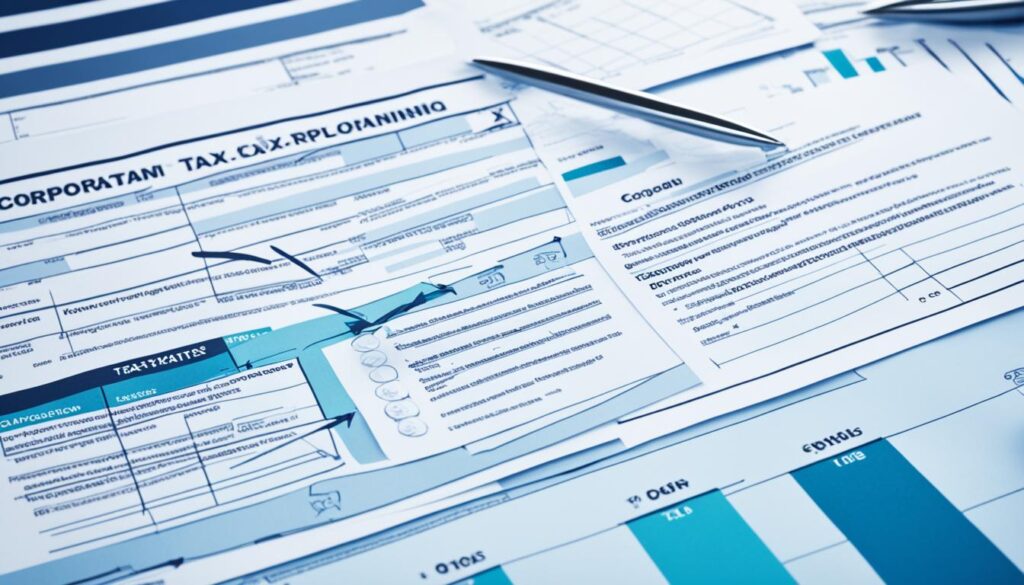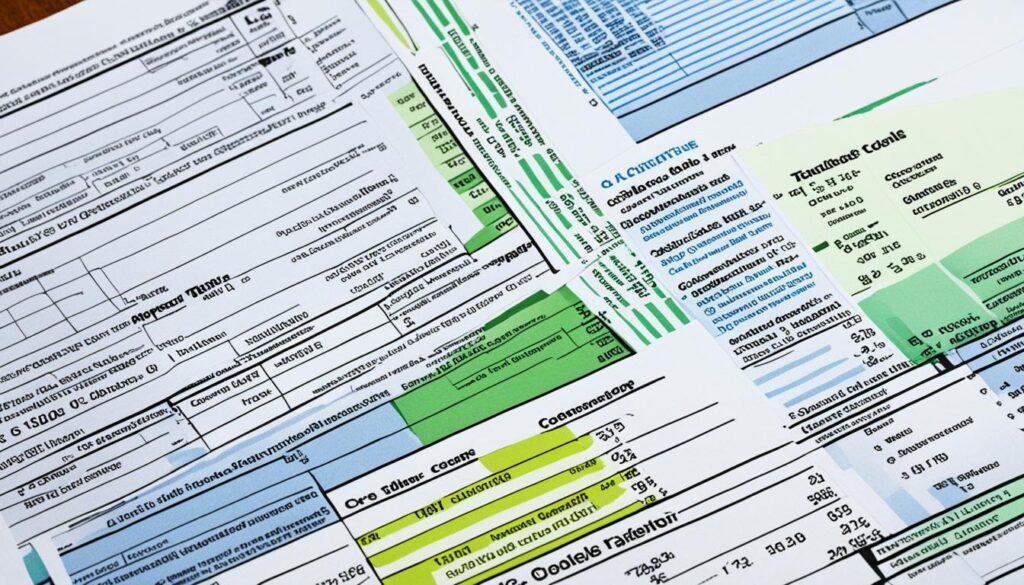Ever wondered why C corporations face double taxation? Curious about its effects on the company and shareholders? This guide goes deep into C corporation tax laws. We’ll look at filing needs, deductions, plus benefits, and strategies. Let’s dive into C corporation taxes and find answers to these questions.

Key Takeaways:
- Double taxation occurs when C corporations are taxed at both the corporate and shareholder levels.
- C corporations offer advantages such as the ability to raise capital through share sales and limited liability protection.
- Strategies like retaining income within the corporation and paying salaries instead of dividends can help reduce the double taxation burden.
- Switching to an S corporation structure avoids double taxation but has specific requirements.
- When considering a C corporation structure, evaluate the benefits and drawbacks based on your business goals and tax obligations.
The Advantages of Structuring as a C Corporation
Choosing to structure a business as a C corporation comes with benefits, despite the double taxation. These companies can issue stock to many shareholders. This opens the door to more investments. They also have the perk of limited liability. This means owners and shareholders don’t have to pay business debts from their pockets. Another bonus is that C corporations can write off costs for things like insurance. This saves money for both the company and its workers.
Benefits of Structuring as a C Corporation
- Raising Capital: C corporations can gather funds by selling shares. This lets them welcome more investments for growth and expansion.
- Limited Liability: C corporations offer a protective shield for owners and shareholders. Their personal assets are safe if the business faces money troubles or legal battles.
- Tax Deductions: Costs for benefits like insurance are deductible. This not only helps employees but also reduces taxes for the corporation.
“Structuring as a C corporation can be an attractive option for businesses looking to raise capital, protect owners and shareholders from personal liability, and take advantage of tax deductions.”
Going the C corporation route means getting more investor opportunities, better liability protection, and tax perks for employee benefits. These pluses make C corporations a go-to for firms aiming for growth, safety, and longevity.
| Advantages of C Corporation |
|---|
| Raise capital by selling shares to multiple shareholders |
| Owners and shareholders are shielded from business debts and liabilities |
| Eligible for tax deductions on employee benefits |
If you make your business a C corporation, you can attract more investments and safeguard your personal assets. You’ll also get tax breaks on employee benefits. It’s wise to consider your business goals and talk with experts. They can help you see if the benefits of a C corp beat the downsides of double taxation.
Understanding Double Taxation on C Corporations
C corporations face double taxation on their earnings. Firstly, the corporation pays taxes on its profits. Then, shareholders pay taxes on dividends they get from those profits.
At the corporate level, C corporations are taxed at a 21% federal rate. This rate is applied to the corporation’s earned profits.
“C corporations must first pay corporate income taxes on its profits at the federal corporate tax rate, which is currently 21%.”
After paying corporate taxes, profits can be given to shareholders as dividends or wages. Then, shareholders must pay taxes on this income too.
The tax rate for individuals varies, going from 10% to 37%. This depends on how much the shareholder earns.
“When dividends and wages are distributed to shareholders, they must pay individual income taxes on those earnings. The individual tax rate can vary depending on the shareholder’s income bracket, ranging from 10% to 37%.”
To follow tax laws, C corporations need to file using IRS Form 1120. This form is known as the U.S. Corporation Income Tax Return.
The C Corporation Taxation Process:
- C corporation earns profits.
- C corporation pays corporate income taxes at a federal corporate tax rate of 21%.
- C corporation distributes remaining profits to shareholders in the form of dividends or wages.
- Shareholders pay individual income taxes on these earnings based on their income bracket.
- C corporation files federal income taxes using IRS Form 1120.
Knowing about double taxation helps C corporations manage their taxes well. They must accurately count profits and follow proper tax filing steps. This ensures they meet all tax rules and rates.

Ways to Reduce Double Taxation on C Corporations
Double taxation is a common issue for C corporations, but there are ways to lessen its impact. Here are several strategies to consider:
- Retaining more business income: Keeping more profit within the company can help fund growth. This means less dividends paid to shareholders, which lowers their taxable income. This can lead to lower taxes overall.
- Paying salaries instead of dividends: Paying shareholders salaries instead of dividends can also reduce taxes. Salaries allow for deductions and are subject to payroll taxes. This can substantially lower the tax amount, especially for those in high tax brackets.
- Splitting income: You can also reduce taxes by dividing income between the corporation and its shareholders. Rent, royalties, management fees, or licensing agreements can do this effectively. It can reduce income taxes for both the company and shareholders.
- Taking out a loan: Instead of paying dividends, the company can loan money to shareholders. This method avoids taxes on dividends. It can lead to lower taxes for both the company and its shareholders.
Using these strategies, you can significantly cut down the double taxation of C corporations. But, always talk to a tax expert or accountant. They can make sure you follow the law and use these methods effectively.

Note: The image above illustrates the importance of effective c corporation tax planning in reducing double taxation.
Example Scenario:
Let’s look at a made-up example to see how these strategies might work. XYZ Corporation, a C corporation, made a lot of profit. They want to lower taxes for both the company and its shareholders.
The company decides to hold back some income for business growth. This means they give out fewer dividends, which lowers taxes for shareholders.
Next, XYZ Corporation pays its shareholders reasonable salaries instead of dividends. These salaries are taxed, but they can use deductions and withholdings.
Also, the corporation makes licensing deals with shareholders. This pays them royalties for using their intellectual property. It divides the income, lowering taxes for both the corporation and shareholders.
By using these methods, XYZ Corporation cuts the double taxation burden. This lets the business and its shareholders keep more of their earnings.
Summary Table: Comparing Strategies to Reduce Double Taxation
| Strategies | Potential Tax Benefits |
|---|---|
| Retaining more business income | Reduces dividend tax liability |
| Paying salaries instead of dividends | Subject to deductions and payroll tax withholding |
| Splitting income | Reduces taxable income for both the corporation and shareholders |
| Taking out a loan | Provides an alternative to taxable distributions |
These strategies offer effective ways to cut double taxation on C corporations. It’s crucial to look at how each one fits your business. Working with tax pros can help you pick the best approach for your situation.
Switching to an S Corporation Structure
If you want to avoid double taxation, think about switching from a C corporation to an S corporation. S corporations don’t face double taxation since their profits go directly to shareholders. This means they are only taxed once.
Before you switch, consider if an S corporation fits your business goals. Also, check if the tax benefits are worth any downsides. S corporations must have fewer than 100 shareholders and just one class of stock.
There are benefits to becoming an S corporation. You can avoid double taxation and still get C corporation liability protection. S corporations also allow profit and loss to be shared differently among shareholders.
Talking to a tax expert or lawyer is key before you make the switch. They can help you understand everything involved. They’ll ensure you meet all requirements for becoming an S corporation.
Comparing C Corporation and S Corporation Structures:
| Factor | C Corporation | S Corporation |
|---|---|---|
| Taxation | Subject to double taxation | No double taxation |
| Shareholder Requirements | No restrictions on number or type of shareholders | Less than 100 shareholders and only one class of stock |
| Liability Protection | Provides limited liability protection for owners and shareholders | Offers limited liability protection for owners and shareholders |
| Distribution of Profits and Losses | Profit and loss distribution flexibility | Profit and loss distribution flexibility |
Switching to an S corporation can deeply affect your business. Think carefully about the pros and cons. Decide how an S corporation matches your business plans for the future.

Evaluating the C Corporation Structure for Your Business
Thinking about your business structure is key. Ask yourself if a C corporation is a good choice. C corporations have benefits like raising capital through selling shares and protecting owners from debts. But, there are important factors to think about too.
Advantages of the C Corporation Structure
Raising capital is easier for a C corporation because it can sell shares. This attracts more investors, helping the company grow.
Owners enjoy limited liability with a C corporation. They’re not personally responsible for company debts. Their risk is limited to their investment.
C corporations also get tax breaks on employee benefits. They can save on taxes by deducting costs for health and life insurance for their workers.
Considerations for C Corporation Structure
Yet, the C corporation structure has its challenges. One major issue is double taxation. Profits get taxed twice: first as corporate income, then as personal income for shareholders.
Running a C corporation is also complex. There are strict rules to follow, like holding meetings and keeping records. It’s essential to know if you can manage these tasks.
Evaluating Business and Personal Tax Status
Deciding on a C corporation requires a close look at your taxes. Consider the impact of double taxation on your profits. Consulting a tax professional is wise. They can help you see if a C corporation matches your financial goals.
Understanding C Corporation Tax Deadlines
As a C corporation, knowing your tax deadlines is very important. These deadlines can change based on your tax year. It’s key to stay on top of these to dodge penalties and interest. Let’s explore the key deadlines for C corporations.
If your company uses the calendar year, taxes are due by April 15th. This is for those whose tax year ends on December 31st.
If your company follows a fiscal year instead, the due date is the 15th day of the fourth month after it ends. The exact due date changes based on your fiscal year’s end date.
Note that if the due date is on a weekend or holiday, you get more time. The deadline moves to the next working day. Missing these deadlines can lead to hefty fines and interest, harming your business’s finances.
Tax Year End Calendar Year Tax Deadline Fiscal Year Tax Deadline December 31st April 15th Varies based on fiscal year end January 31st May 15th Varies based on fiscal year end February 28th June 15th Varies based on fiscal year end You can ask for more time to prepare and file your C corporation taxes with an extension. Use IRS Form 7004 for an extra six months. But remember, this doesn’t extend your time to pay. You must pay taxes by the original deadline to avoid penalties.
By knowing and planning for these deadlines, you can keep your tax obligations in check. Avoid financial issues by filing on time. It’s smart to get help from a tax professional or accounting services for accurate filing.
Comparing C Corporation Tax Requirements to Other Business Entities
When looking at the C corporation structure, compare it to other businesses. C corporations have their own tax rules that could affect your choices.
Advantages of C Corporations
- Tax advantages: C corporations don’t pay self-employment tax on profits. This might save money compared to other entities. The 21% flat tax rate for C corporations can also be lower than individual tax rates.
- Tax-free benefits: C corporations can get tax breaks for retirement plans and insurance. This offers more chances to save.
Considerations for C Corporations
- Double taxation: A big point to think about is double taxation. C corporations pay taxes on profits. Shareholders then pay taxes on dividends. This could raise the tax load for the business and its owners.
Evaluating the pros and cons of the C corporation against other entities is key. Look at S corporations, partnerships, and sole proprietorships. Each has its own tax roles and needs.
Quote: “C corporations have unique tax perks, but don’t ignore the risk of double taxation. It’s crucial to think deeply about tax rules when picking the best business structure.” – [TAX EXPERT NAME], Tax Expert
Comparison of Tax Requirements
| Business Entity | Tax Considerations |
|---|---|
| C Corporation |
|
| S Corporation |
|
| Partnership |
|
| Sole Proprietorship |
|
By comparing tax rules of different entities, you can choose if a C corporation is right for you. This decision depends on your business needs and tax goals.
C Corporation Tax Planning Opportunities
Operating as a C corporation opens up various tax planning chances during the business’s life. These opportunities allow you to better your tax stance and lower your tax load. Here are key strategies for C corporations:
1. Withholding Dividends
Withholding dividends is one way C corporations can plan taxes. By not distributing earnings, the company can delay tax payments on these dividends. This approach is helpful if your business pays high taxes or wants to reinvest earnings.
But, it’s key to find a balance. You must consider both retaining earnings and the needs of your shareholders.
2. Paying Salaries Instead of Dividends
Another strategy is paying salaries to shareholders rather than dividends. Salaries are a deductible cost for the corporation, which reduces taxable income. Shareholders pay individual taxes on their salaries, which might be lower than dividend taxes.
Yet, it’s vital to make sure salaries are reasonable. They should match the actual value of the services provided.
3. Reimbursing Shareholder Expenses
C corporations can also cover some costs shareholders incur for the company. These reimbursements lower the company’s taxable income. This can cut down the corporation’s tax liability.
However, proper documentation is necessary. It ensures these payments meet IRS rules.
4. Maximizing Deductions
C corporations can take advantage of deductions to reduce taxable income. They can deduct costs like employee wages, rent, and supplies. Business can also deduct benefits for employees, such as health insurance.
Identifying these deductible expenses properly can help minimize tax payments. It’s crucial for saving on taxes.
5. Recording Net Operating Losses
If your C corporation reports a net operating loss, you can use it to balance taxable income in other years. This helps during tough times. It can reduce taxes owed.
But, follow IRS rules closely. They guide how to treat these losses.
6. Accelerating Depreciation
C corporations can speed up depreciation on certain assets. This lets them deduct more of the asset’s cost sooner. These immediate tax savings reduce overall taxes.
However, always seek advice from tax experts. They can help assess the impact of this choice.
7. Claiming Tax Credits
Tax credits directly cut down on taxes owed by a corporation. C corporations qualify for different credits, such as for research or energy-efficient upgrades. Claiming these credits can significantly lower tax dues.
It’s critical to check eligibility and needed documentation carefully.
Leveraging these tax strategies helps C corporations improve their tax situations. Yet, always consult with tax experts. They ensure your choices comply with tax laws and fit your business goals.

Considerations for Choosing a C Corporation Structure
When thinking about a C corporation, there are key factors to consider. If you’re looking to get investors and raise funds by selling shares, this structure might suit you best. It offers good protection against personal liability for those involved. Yet, it’s important to check if you can manage the dual taxation without hurting your profits. If double taxation seems like a burden, or if you’re not looking into having shareholders or reinvesting profits, a C corporation might not be for you.
Thinking about a C corporation? Here are some important points:
- C Corporation Tax Planning: Double taxation is key in C corporation tax planning. Check if you can manage the tax obligations for both corporate and individual taxes.
- C Corporation Tax Benefits: Look at the possible tax advantages like deductions for benefits and tax credits. See how these fit with your business aims.
- C Corporation Tax Requirements: Get to know the specific tax needs for C corporations. This includes filing times, reporting duties, and following IRS rules.
- C Corporation Tax Planning: Plan your taxes well to reduce your tax load and increase deductions. Look for tax planning chances.
Picking the right business setup needs careful thought about your goals, financial situation, and tax planning aims. Talking with tax experts and lawyers can offer deep insights. They help you make a choice that fits your business’s unique needs.

Partnering with Bench for C Corporation Tax Compliance
Handling C corporation tax can be tricky. There are many rules and deadlines to follow. Bench is here to help.
They offer expert bookkeeping and help with tax filing, including IRS Form 1120. With Bench, you’re ready for the C corporation shift. They make sure tax tasks are less stressful.
Our team knows the ins and outs of C corporation taxes. They offer timely help and keep up with tax changes. This way, your returns are correct, avoiding errors and penalties.
Bench helps business owners concentrate on growing their business. Their professionals work with you. They ensure their services fit what your business needs.

Simplify Your Tax Compliance with Bench
Working with Bench for C corporation taxes brings many pluses:
- Expertise: Our tax pros know lots about C corporation taxes. They’re always learning about new tax laws to help you the most.
- Accuracy: We carefully check your finances and do your taxes right. Trusting Bench means less chance of expensive mistakes or audits.
- Efficiency: We know deadlines are crucial. Our smooth process and advanced tech help get your taxes done fast. This lets you focus on your business.
- Peace of Mind: Bench takes the tax worries off your shoulders. We handle all the complex tax stuff, so you have more time for what’s important.
Partnering with Bench lets you use your time and resources better. It reduces stress and makes sure your taxes are spot-on and on time.
| Benefits of Partnering with Bench for C Corporation Tax Compliance |
|---|
| Expertise in C corporation tax regulations |
| Accurate and timely tax return preparation |
| Efficient processes to meet tax deadlines |
| Peace of mind knowing your tax compliance is in capable hands |
Don’t get bogged down by the hassle of C corporation taxes. Join forces with Bench. Enjoy the ease, accuracy, and peace of trusted tax experts.
Making Informed Decisions for Your Business
When running a business, deciding on your structure and tax plans is key. Think about becoming a C corporation; it has benefits. C corporations can raise money by selling shares. This helps your business grow.
Owners and shareholders of C corporations get protection. They are not personally liable for business debts. This is a big advantage.
Yet, understand that being a C corporation involves complex tax planning. There’s double taxation to consider. The company and the owners are taxed on the profits. This might affect your earnings.
Work with experts like accountants and lawyers to explore the C corporation path. They will tell you how it affects your taxes and profits.
Know the tax pros and cons of a C corporation before deciding. It’s about more than just raising money and getting liability protection. With the right advice, your business can thrive while meeting its goals.
